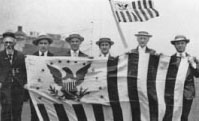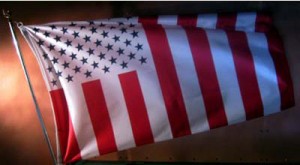All About Our Flags
The first U.S. Flag, which denoted civilian versus military purposes, was designed in 1799 by Oliver Wolcott Jr. the Secretary of the Treasury under John Adams. Wolcott’s proposal featured: An ensign, consisting of sixteen alternating red and white stripes representing the number of states that had joined the Union by 1799; and the Union, represented by the small rectangle in the upper left corner, with its Arms (an Eagle) of the United States in dark blue on a white field.
It is significant that Wolcott’s new civilian flag had vertical stripes, not horizontal. This was done so that non-military ships would be easily recognized and not fired upon as they tried to hail and board foreign vessels. This new flag was actively flown on Revenue Cutters, what we now call Coast Guard Cutters. The original purpose of the Revenue Cutter was to collect tariffs and other taxes that were imposed on foreign goods. The Revenue Cutter ensign had vertical stripes to denote civilian authority under the Treasury Department rather than military authority under the War Department.
The First U.S. Civil Flag 1799
In the early days of our nation, horizontal stripes became the accepted practice for use over military posts, and vertical stripes were used over civilian establishments. The use of the Civilian Flag also spread to Merchants and Common citizens to symbolize their Constitutional rights.
The Civil Flag had red and white vertical stripes with blue stars on a white background. By the Law of the Flag, the vertical striped design denoted Roman Civil jurisdiction within Federal territories rather than Military jurisdiction under Admiralty law. The practice of using the Customs Flag as a Civil Flag became encoded law in 1874 when Treasury Secretary William. A. Richardson required all customhouses to display the Civil Flag.
Where did Wolcott get the idea of using vertical stripes from?
Why did Wolcott choose to turn the horizontal stripes of Old Glory ninety degrees? We need to return to the beginnings of the American Revolution to satisfy this query.
In Boston, the Sons of Liberty were the original revolutionary group who sparked the initial rebellion against the British in 1765. The Stamp Act was imposed by the British Parliament to tax all forms of legal documents within their American colonies. The Stamp Act created great unrest in America, especially in Boston, where an effigy of the local stamp agent, Andrew Oliver, was hanged and burned. Eventually, Oliver resigned, his home looted, and the stamps destroyed. The Elm tree Oliver was hung on became known as the “Liberty Tree”
The Stamp Act rebellion initiated the Stamp Act Congress, which gathered representatives from nine of the thirteen colonies. A petition of rights and grievances was drawn up declaring that the colonists “were entitled to all the inherent rights and liberties of natural born subjects.” The colonies also declared that “no taxes ever have been, or can be constitutionally imposed upon them, but by their respective legislatures,” and that it “was unreasonable and inconsistent; for the people of Great Britain to grant to His Majesty the property of the colonists.”
The petition asserted that extending the courts of ADMIRALTY, the law of the seas, in order to prosecute the Act undermined “the rights and liberties” of the colonists. So, the original “common law flag” was first raised over the Liberty Tree in Boston. The “rebellious stripes”, as the flag came to be called, was the original flag used by the Sons of Liberty, and it had 9 red and white vertical stripes!
Sons of Liberty
“Rebellious Stripes” Flag 1767-1775
Why did they choose red and white vertical stripes as their symbol?
Was the flag with vertical stripes a way of rebelling against the British East India Company? The British-East India Company flag had red and white horizontal stripes with the Union Jack in the upper left-hand corner. The first official flag of the American Revolution was the “Grand Union” flag first flown by General Washington on January 2nd 1776 at Cambridge Massachusetts.
Coincidentally it was also the same EXACT flag as the BRITISH-EAST INDIA COMPANY. It flew for over a year after the signing of the Declaration of Independence! An Anonymous individual of European descent known only as the ‘Professor’ recommended the BEI Company flag to Ben Franklin and the flag committee.
It has been reported that this mysterious individual was none other than Jesuit General Lorenzo Ricci, head of the Jesuit order. General Ricci supposedly had died in a Vatican prison six months prior. Pope Clement XIV the man who suppressed the Jesuit order in 1773 and had General Ricci imprisoned, soon died early 1774, apparently poisoned. The Vatican Treasurer at that time was General Ricci’s, best friend and former classmate Cardinal Braschi. Braschi controlled the Vatican resources as acting Pope during the beginning of the American Revolution..
It appears that the Jesuits via the Vatican bank may have funded the American Revolution. It would explain the seat of the new American government being set up on a Roman-Catholic possession and the institution of Roman-Civil Law as the law of the United States territories. i.e. the District of Columbia.
Grand Union Flag Jan. 2, 1776-1777
Although not a true Sovereign flag, only a State flag with a Common Law seal can directly represent the Common Law. There is an indirect relationship to Individual and state sovereignty with the U.S. Civil Flag.. A solvent federal government flying a Civil flag, implies solvent States/Nations with Sovereign citizens.
When we first came across the Civil flag and decided that this flag should be the symbol for all sovereign citizens we looked back to the Sons of Liberty and their “Rebellious Stripes” flag as our example. We wanted a flag that would address the deep need in Americans to awaken and return to a time when our government was not “Big Brother” hidden under the name of the Patriot Act! Just as some surmise how the Sons of Liberty turned the British East India Company’s flag on its side; we also decided to turn Old Glory on its side. We wanted the flag to represent our modern Union of States, we chose to create a flag that had 13 vertical stripes and 50 blue stars on a white background: One star for each Sovereign State of the Union of the united States of America!
U.S. Sovereign Flag, Jan 2004
Our civilian flag is a way of reminding Americans, as well as our leaders, that every man and woman is sovereign and that we are all endowed by our Creator with life, liberty and the pursuit of happiness. This sovereign Civil Flag is a symbol of our desire to return America to the dreams upon which she was founded!
~USCivilFlags.org
Note: the Flag that we daily see is a military flag, and which is why much of the issues in our country still exist especially from the alleged corporate world that have us the people enslaved as if we are at war with them!
This mammoth fabricated lie have got to END, as we are declaring peace with the now dissolved corporation which headquarters are in Washington DC.
Meanwhile know the differences in the Civil Flag and the Military Flag, and start being what you are: a sovereign America citizen under one sky, one people, one Flag, and one love.










Love it!